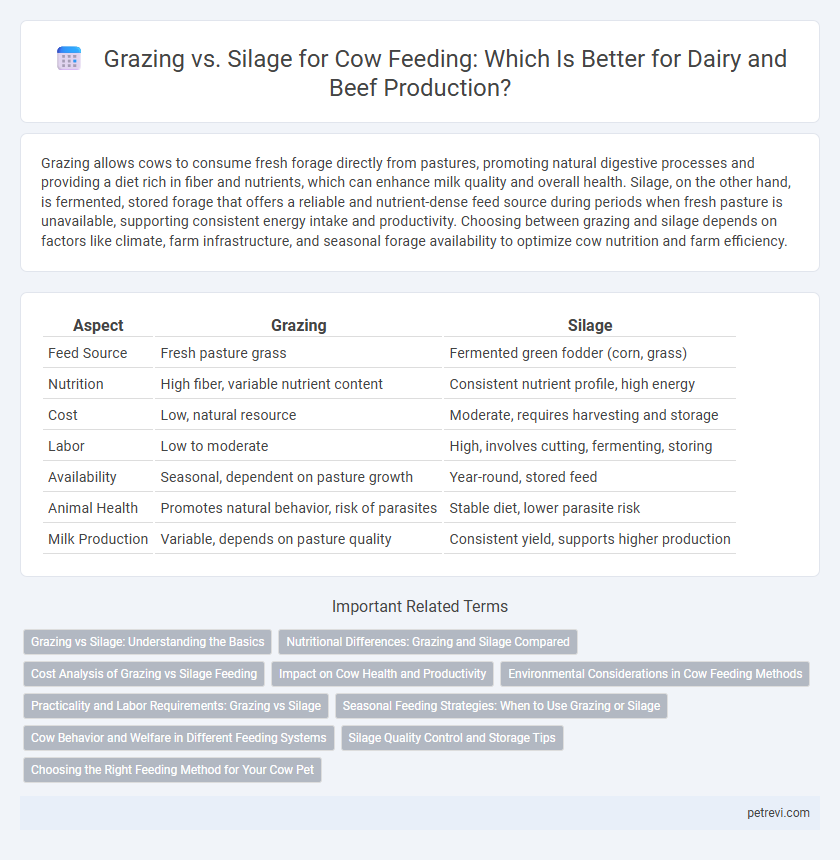Grazing allows cows to consume fresh forage directly from pastures, promoting natural digestive processes and providing a diet rich in fiber and nutrients, which can enhance milk quality and overall health. Silage, on the other hand, is fermented, stored forage that offers a reliable and nutrient-dense feed source during periods when fresh pasture is unavailable, supporting consistent energy intake and productivity. Choosing between grazing and silage depends on factors like climate, farm infrastructure, and seasonal forage availability to optimize cow nutrition and farm efficiency.
Table of Comparison
| Aspect | Grazing | Silage |
|---|---|---|
| Feed Source | Fresh pasture grass | Fermented green fodder (corn, grass) |
| Nutrition | High fiber, variable nutrient content | Consistent nutrient profile, high energy |
| Cost | Low, natural resource | Moderate, requires harvesting and storage |
| Labor | Low to moderate | High, involves cutting, fermenting, storing |
| Availability | Seasonal, dependent on pasture growth | Year-round, stored feed |
| Animal Health | Promotes natural behavior, risk of parasites | Stable diet, lower parasite risk |
| Milk Production | Variable, depends on pasture quality | Consistent yield, supports higher production |
Grazing vs Silage: Understanding the Basics
Grazing provides cows with fresh pasture rich in fiber and natural nutrients, promoting better rumen function and overall health compared to silage. Silage offers a high-energy, preserved feed option that ensures consistent nutrition during off-season months or poor grazing conditions. Balancing grazing and silage intake optimizes feed efficiency, milk production, and animal well-being by leveraging the benefits of both fresh forage and conserved feed.
Nutritional Differences: Grazing and Silage Compared
Grazing provides cows with fresh forage rich in fiber, vitamins, and antioxidants, promoting rumen health and natural feeding behavior. Silage, fermented forage stored for long periods, offers higher energy density and consistent nutrient supply, particularly elevated levels of fermentable carbohydrates and preserved protein content. Nutritional differences influence milk production, digestion efficiency, and overall cow health, with grazing favoring natural nutrient intake and silage ensuring stability and availability in off-seasons.
Cost Analysis of Grazing vs Silage Feeding
Grazing typically incurs lower direct costs than silage feeding due to reduced expenses for harvesting, storage, and feed processing, making it more cost-effective for dairy and beef operations with adequate pasture land. Silage feeding involves significant initial investment in equipment and infrastructure, along with higher energy inputs for fermentation and preservation, but provides consistent feed quality and availability year-round. Cost analysis must consider regional factors like land rental rates, labor, and seasonal feed variability to determine the optimal feeding strategy for maintaining cow health and maximizing production efficiency.
Impact on Cow Health and Productivity
Grazing on fresh pasture provides cows with a natural diet rich in fiber and essential nutrients, promoting better rumen health and higher milk quality. Silage, while energy-dense and available year-round, can sometimes lead to digestive disturbances due to fermentation acids if not properly stored or managed. Balanced feeding strategies combining fresh grazing and high-quality silage optimize cow productivity by supporting immune function and sustained milk yield.
Environmental Considerations in Cow Feeding Methods
Grazing supports carbon sequestration in pastures and promotes biodiversity, reducing the overall environmental impact compared to silage, which requires energy-intensive harvesting and storage processes. Silage production generates higher greenhouse gas emissions, particularly methane and nitrous oxide, due to soil disturbance and feed fermentation. Implementing rotational grazing systems enhances soil health and lowers reliance on synthetic fertilizers, further mitigating environmental footprint in cow feeding practices.
Practicality and Labor Requirements: Grazing vs Silage
Grazing requires less daily labor as cows feed themselves naturally on pasture, reducing feed handling and storage needs. Silage demands more intensive management, including harvesting, chopping, fermenting, and daily feeding, increasing labor and equipment use. Practicality favors grazing in systems with ample pasture, while silage suits operations prioritizing feed quality control and year-round availability.
Seasonal Feeding Strategies: When to Use Grazing or Silage
Seasonal feeding strategies for cows vary based on pasture availability and nutrient requirements, with grazing prioritized during spring and summer when fresh forage is abundant and high in energy. Silage becomes essential in autumn and winter, providing a preserved feed source rich in fiber and energy to maintain milk production and body condition when pasture growth slows. Efficiently balancing grazing and silage optimizes cow health and farm productivity throughout the year.
Cow Behavior and Welfare in Different Feeding Systems
Grazing allows cows to express natural foraging behaviors, promoting better welfare through increased movement and social interaction. Silage feeding, while ensuring consistent nutrition, may limit physical activity and behavioral diversity, potentially impacting cow well-being. Understanding the behavioral differences between grazing and silage systems is crucial for optimizing feeding strategies that support both health and welfare.
Silage Quality Control and Storage Tips
Silage quality control for cow feeding hinges on proper fermentation, moisture content, and avoidance of mold to preserve nutritional value and prevent health issues. Effective storage involves airtight silos or sealed bags to minimize oxygen exposure, which can lead to spoilage and nutrient loss. Regular monitoring of pH levels and temperature during storage ensures optimal fermentation and maintains the feed's digestibility and palatability for maximum milk production.
Choosing the Right Feeding Method for Your Cow Pet
Grazing offers cows fresh pasture rich in natural nutrients and promotes natural foraging behavior, which supports better digestion and overall health. Silage provides a reliable, high-energy feed option during seasons when pasture is unavailable, ensuring consistent nutrition through preserved forage. Selecting the right feeding method depends on pasture availability, climate conditions, and the specific nutritional needs of your cow to optimize health and productivity.
Grazing vs Silage for Cow Feeding Infographic

 petrevi.com
petrevi.com